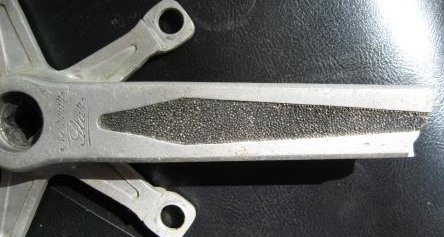Sugino "Mighty Tour", failed at pedal end of vanity groove. Pedal eye portion is not available.
![[X]](ic3257.125.crop.jpg)
![[X]](ic3255.500.crop.jpg)
The presence of extensive "beach marks" indicates this was a fatigue failure rather than an overload failure.
Failure occured near the end of the outer vanity groove, but the failure did not occur where the section is thinnest, in the part of the arm where where there are both outside and inside grooves.
If failure was due to torsion load, such as pedal load at 3 o'clock, failure would be expected in the part with the smallest torsional strength and stiffness, which is the part with grooves on both sides. Instead, the load appeared at the end of the outer groove, which indicates a failure from bending load near the bottom of the pedal stroke.
Nervar "Star", failed awt pedal end of vanity groove. Pedal eye portion not available.

![[X]](ic3260.250.crop.jpg)
Again, note the presence of "beach marks". Here, almost half the crank was cracked before the remaining part was so weak it failed.
The failure is near the pedal eye end of the vanity groove. The vanity groove is of progressively wider section; if the failure-inducing load was uniform along the length, failure most likely would have happened at the widest point of the groove. Instead, it happened near the pedal eye. The "beach marks" indicate the failure started on the outside face and worked in. This indicates failure from load applied at the bottom of the pedal stroke.
Mavic crank; similar to the 637 but 130mm BCD for "road" use. Cracked at transition from arm to spider.
![[X]](ic3291.125.crop.jpg)
![[X]](ic3289.250.crop.jpg)
Crank is 180mm, which suggests a heavier rider.
The sharp "knife edge" transition betwen the arm and spider is a frequent point of fialure across brands of cranks.
The failure is consistent with pedaling loads being concentrated along the thin transition.
Some cranks mill away the sharp edge to reduce stress concentration.